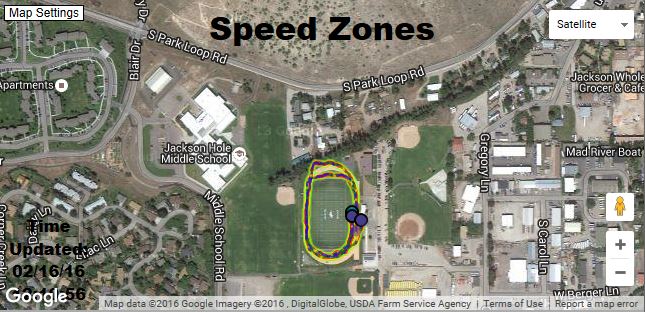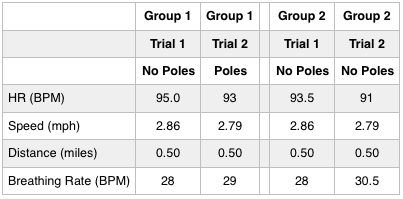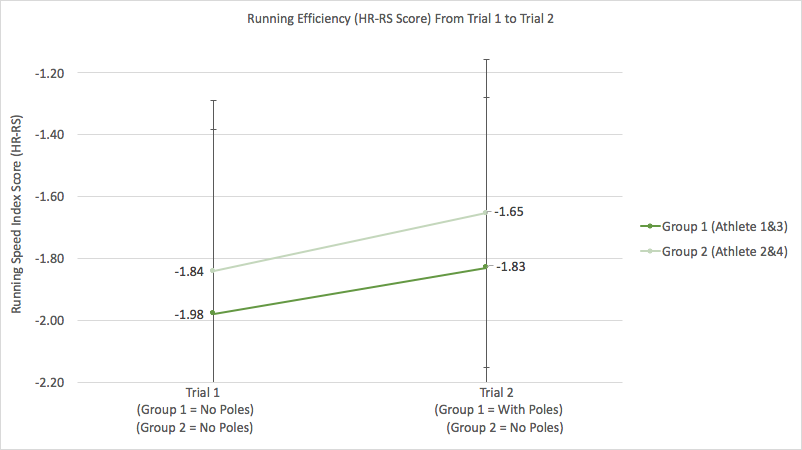
Part I: Previous Research and Mini-Study #1
Adam Scott, MS, CSCS
One of the many things which Military and Mountain Athletes have in common is the requirement to move over ground (typically under load). This prevailing operational demand is a critical component in the MTI training philosophy.
As long as this demand remains, MTI is going to train for it…
…But, what if there was, in addition to training, an easy way to improve an athlete’s ability to cover ground on foot?
Well, it turns out one solution might already exist: Trekking Poles.
Anecdotally most people believe that trekking poles: reduce impact on your joints, help establish a walk rhythm, increase traction, assist balance and help displace weight (1).
However, there are also some perceived draw backs: Increased energy expenditure, increased weight, upper body injuries and encumbered hands (1).
Unfortunately, on the scientific-side, all of the available research has been conducted in labs, on treadmills. And, even in these highly-controlled laboratory settings, the studies have produced mixed results.
So, earlier this week we started our own series of experiments examining the effect of trekking poles. Here is what the previous research says and what our first pilot-study revealed.
PREVIOUS RESEARCH:
The three studies we examined which looked at horizontal movement produced split results. One found that trekking poles had no effect (2). Another found that using poles decreased efficiency (more metabolic demand at similar speeds) (3). And the final study found that poles increased efficiency (more speed and less force) (5).
Both of the uphill studies we reviewed found that trekking poles decreased lower body (LB) joint stress, while increasing stride length. However, the studies were split on trekking pole’s metabolic effect (2,4).
The two downhill studies cited below found a slight decrease in efficiency, but large improvements in LB joint stress (2,6).
Below, in TABLE 1, 2 and 3, you will find a summary of the studies we examined. TABLE 1 contains studies looking at horizontal movement, TABLE 2 contains uphill studies and TABLE 3 contains downhill studies. Cells with “up” arrows represent instances where trekking poles had a positive effect, “down” arrows represent a negative impact, and an “equals-sign” means no impact. Attributes not assessed or reported were left blank.
TABLE 1: Horizontal (→) Trekking Pole Results

TABLE 2: Uphill (↖︎)Trekking Pole Results

TABLE 3: Downhill (↘︎) Trekking Pole Results

“LB Joint Stress” = Lower Body Joint Stress
“HR” = Heart Rate
“O2 Cons” = Oxygen Consumption (VO2)
“Br Rate” = Breathing Rate (Breaths per minute)
“Steps” = Step/Stride Length
“Speed” = Movement Speed
“RPE” = Rate of Perceived Exertion
Based on the mixed results found in the highly regulated laboratory studies above, our plan is to test things for ourselves…under real-world, real-life conditions. The four conditions we want to examine are:
-
-
- Horizontal Unloaded Movement
- Horizontal Loaded Movement
- Incline Unloaded Movement
- Incline Loaded Movement
-
So far we have conducted two pilots studies. Here are the results from our first pilot-study on Horizontal, Unloaded Movement:
PILOT STUDY 1: HORIZONTAL UNLOADED MOVEMENT PILOT-STUDY:
Four athletes completed two walking trials. Each athlete was randomly assigned to one of two groups. The group averages are contained in TABLE 4.
Each group contained one male and one female athlete. As you can see, the groups were fairly similar, especially in their performance measures (HR rest, VO2max Speed, and HR VO2).
TABLE 4: Group Demographics

Study Trials:
For the first trial, all athletes walked over a flat surface for 0.5 miles (400m running track). All four athletes were required to maintain the same, self-selected pace. Speed, HR, Breathing Rate (BR) and total steps were collected using our Zephyr Bioharnesses and paired GPS trackers. Trial one was used to establish a baseline score for each athlete.
For the second trial, we randomly divided the athletes into two groups. Both groups then completed the same 0.5 mile course using a similar, self-selected pace. The sole difference between the trials was that group 1 was assigned trekking poles and group 2 was not.
Thus, group 1 acted as the treatment group (trekking poles) and group 2 served as the control group (no change). To determine the effect of the trekking poles we compared the group changes from trial one and trial two.

Results and Discussion:
For all four athletes trial 1 was 0.5 miles completed at 2.86 mph, and trial 2 was 0.5 miles completed at 2.79 miles per hour. The slight difference is speed was due to the self-selected nature of the events. However, since each group completed the same distance at the same speed the variation was effectively cancelled out.
TABLE 5 contains the per-trial data for each group. As you can see below both groups experienced extremely sight changes from trial one to trial two. Comparing the between-group changes shows very little difference between the trekking pole and non-trekking pole treatments. For example group 1 (trekking pole) experienced a 2BPM rise in heart rate and group 2 (non-pole) experienced a 2.5BPM rise.
TABLE 5: Group Results from Trial 1 and Trial 2

Using a standard T-test statistical analysis, none of the differences were found to be significant. Thus, the results in table 5 would seem to support the fact that trekking poles had very little impact on performance.
However to get a true measure of metabolic efficiency we decided to calculate what is called a “Heart Rate-Running Speed Index” ) (HR-RS) (7-8). This index is based on the finding that HR and running speed have a linear relationship. It is typically used to assess endurance training adaptation – increasing HR-RS numbers indicate increasing efficiency. Thus, if trekking poles do improve efficiency, we should see a measurable increase in HR-RS (compared to the control group).
FIGURE 2 and 3 show the equations used to calculate Heart Rate-Running Speed Index (8).
FIGURE 2 and 3: Equations


GRAPH 1: Trial 1 and Trial 2 Running Efficiency Scores

Initial Conclusion:
However, to our knowledge this was also the first study which attempted to assess the effect of trekking poles on performance outside of a laboratory. Based on our limited results, it seems as though trekking poles have little to no impact on outdoor, horizontal, unloaded walking efficiency.
Our real-world results support findings from Perrey, et al. (2007) which showed no measurable effects from trekking poles during horizontal treadmill walking (2).
On the other hand, our findings are contrary to Porcari, et al. (1997) which found that trekking poles significantly increased metabolic demand (3), and findings from Wilson, et al. (2000) which showed that poles created more efficiency (more speed and less force) (5).
Hopefully our further studies will be able to add more weight to these findings.
REFERENCES:
(1) McNamara, C and Neale, M. Ten reasons for trekking poles. Outdoor gear lab. Published: 29 JUL 2014. http://www.outdoorgearlab.com/a/11089/Ten-Reasons-for-Trekking-Poles. Accessed: 17 FEB 2016.
(2) Perrey, S. and Fabre, N. Exertion during uphill, level and downhill walking with and without hiking poles. J of Sport Sci and Med; 7: 32-38. 2007.
(3) Porcan, J, Hendrick, T, Walter, P, Terry, L and Walsko, G. The physiological response to walking with and without power poles on treadmill exercise. Res Quarterly for Ex and Sci; 68(2): 161-166. 1997.
(4) Knight, C and Caldwell, G. Muscular and metabolic costs of uphill backpacking: are hiking poles beneficial? Med & Sci in Sport & Ex. FEB 2000.
(5) Wilson, J, Torry, M, Decker, M, Kernozek, T and Steadman, J. Effectos fo walking poles on lower extremity gait mechanics.Med & Sci in Sport & Ex. MAR 2000.
(6) Schwameder, H and Muller, E. Comparisons of knee joint forces during downhill walking with and without hiking poles. J of Sport Sciences; 17: 969-978. 1999.
(7) Hutchinson, A. Tracking FItness with the “Heart Rate-Running Speed Index.” Runner’s World. www.runnersworld.com. Accessed: 17 FEB 2016.
(8) Vesternin, V, Hooka, L, Hynynen, E, Mikkola, J, Hakkinen, K and Nummela, A. J of Strength Cond Res; 28(4): 902-908. 2014.
